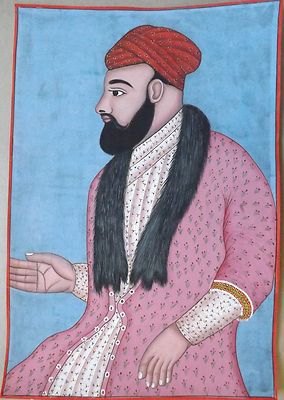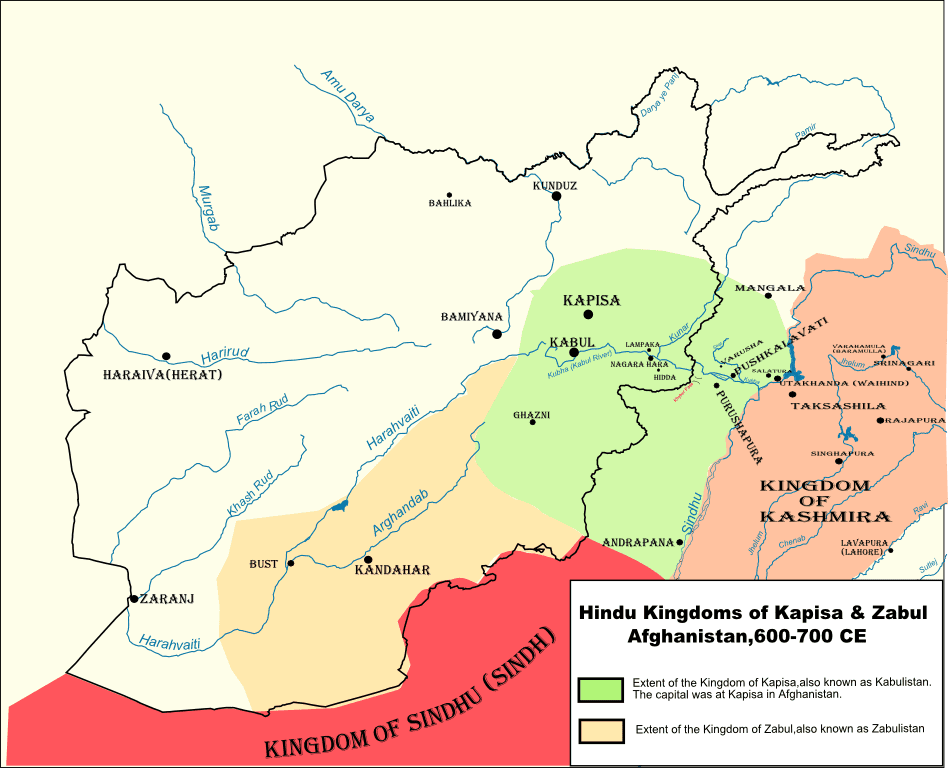This is the tale of the heroic defense provided by the Shahi (Shahiya) kingdom of Afghanistan against the Arabs warlords, whose aim was to spread Islam by swords to new regions. These shahi kingdoms resisted the Arabs invasions for more than 200 years.
The two kingdoms that fought against the first wave of the Arabs were the kingdom of Kabul and Zabul. The kingdom of Zabul (Zabulistan) was located around modern Balochistan, and the kingdom of Kabul was north of Zabul.

The Shahi dynasty ruled over Kabul and the old province of Gandhara from the decline of the Kushan empire, in the 3rd to the 9th century. This kingdom was also known as the Kabul Shahi dynasty when they ruled over Kabul and later when they moved their capital to the Hund, they were called the Shahi dynasty.
Known as Ranbal, Rutbil, Ratbil (it can be interpreted as Ratna-pala) in Islamic texts, this king’s name has not only been forgotten but has been completely wiped out from the pages of Indian history.
Content
Background: Shahis (Shahya) of Afghanistan & the Islamic Conquests of Arabs
The kingdom of Zabul (Zabulistan) whose rulers took the title of the ‘Shahs ‘ or Shahya was situated on the southern part of modern-day Afghanistan.
The conquerors of the world i.e. the Arabs, who not only carved one of the biggest empires of that time but were also superior warlords as compared to its neighboring kingdoms.
After subjugating Persia in 643 AD and motivated by religious zeal they decided to invade the Kabul Valley in 650 AD. The governor of Basra i.e. Abdallah ibn Amir ordered Ar-Rabi ibn Ziyad to invade Sistan (Seistan).
It is believed that Ar-Rabi was successful in his initial campaigns and was able to advance as far as Lashkar Gah (Laskargah). But soon after this success ar-Rabi and his army were forced to retreat from their newly conquered land. The governor or Satrap who defeated ar-Rabi and his army is has the name of Ranbal in Islamic texts.
The Arabs were furious from this defeat and within three years after this defeat Abdallah ibn Amir ordered Abd ar-Rahman or Abdu-r Rahman to finish the Shahis and subjugate Kabul and Seistan.

Initially, the army of the Arabs under Rahman was able to capture Sistan and was also successful in capturing incalculable wealth and prisoners of war too.
The next aim of the Arabs was Kabul and when Abd-r Rahman was made the governor of Seistan the Arabs under him didn’t hesitate to invade the kingdom of the Shahi’s at Kabul.
HINDU Resistance of the Shahis and the continous defeat of the Arabs
Alarmed by the invasion of his kingdom the king of Kabul sent a request to the Indian kings for help. The Arabs were able to siege Kabul for almost one month.
The king of Kabul initially agreed to pay an annual tribute to the Arabs in order to protect his kingdom and city from plundering. Then the army of the Arabs marched for Zabul.
Later in 683 AD the people of Kabul revolted against the arab governor i.e Yazid ibn ziyad ibn Abihi. The revolt of the people of Seistan is known as the battle of Junzah in which the governor of Seistan was killed and the arabs were forced to retreat from Seistan.
It is believed that the arabs were forced to pay 500000 dirhams to the Hindu King Ranbal. But soon after this battle the Hero of Seistan i.e Ranbal was killed by Umair al-Mazini. After the death of Ranbal, his son who had already gained military capabilities took the name of Ranbal and continued the struggle of the Hindus against the Arab warriors.
Failed Arab Expedition in 692 AD
In 692 AD when Abd-ullah was appointed as the new governor of Seistan the arabs were again in the mood of another invasion.
Ranbal (can be considered as Ranbal 1 as his father had the same title Ranbal) was familiar with the geographic significance of his kingdom and allowed the army of the Arabs to penetrate deep inside his kingdom.
Later when the invader were inside his kingdom king Ranbal decided to siege all the mountains passes and paths of his region. The invading army was trapped and the hunters became hunted. To save his kingdom, Ranbal offered a treaty in which he gave a sum of 300,000 dirhams to the Arabs and in return the arab will never invade his land.
Abd-ullah agreed on this. When news of the treaty reach to Caliph, he removed Abd-ullah from his post.
Period of Al-Hajjaj : More failed Arab Invasions of India
When Al-Hajjaj became Caliph (at Basra, Iraq) he immediately sent another warrior named as Ubayd-ullah to Seistan.
Ranbal applied the same tactic which he used against Abd-ullah and trapped the entire army of Ubayd-ullah. Furious by this siege ,Ubayd-ullah agreed to sign peace treaty, but his general Shuraih ibn Hani al-Harithi did not agree and decided to fight till his last breath.
A furious battle started and the already demoralized army of the Arabs were crushed along with their captain Shuraih. The Arab army decided to retreat and were able to reach Bust. The desert area of Bust region further harassed the already tired Arabs. Many soldiers died due to thirst and hunger and the campaign of invasion of Seistan resulted in a total defeat for the Arabs.
Note: Ubayd-ullah’s 3 sons were captured by Ranbel.

But al-Hajjaj was still not satisfied for this and in 700 AD he again decided to invade the kingdom of Kabul (Ranbel), this time with more powerful army than ever before.
A total of 40,000 men were sent under the leadership of Abd-ar Rahman ibn Muhammad. Abd—ar Rahman was able to loot Seistan but didn’t go beyond this region. Furious from this act, Al-Hajjaj issued a serious threat to suppress Abd-ar Rahman.
To save himself from the Caliph Abd-ar Rahman signed a treaty with Ranbel and asked that both will protect each other. But Abr-ar Rahman committed suicide probably from growing tension between him and Al-Hajjaj.
According to Al-Baladhuri (Arab historian) ,Al-Hajjaj made peace treaty with Ranbal. He further tells that the king of Kabul or Zabul did pay some dirhams in every year but these tributes were temporary and Seistan was never subjugated completely.
This kingdom of Zabul and Kabul were able to resist the Arabs for almost 200 years (650- 860 AD). Their descendants also fought a series of wars against the mighty Arabs even in 867 AD.
It was in the late ninth century when the kingdom of the Shahi Dynasty fell completely. As by this time, Arabs were replaced by the Turks, who were fearsome warlords and their most powerful leader Mahmoud Ghazni was able to subjugate this Shahi Kingdom.
This was the story of epic resistance provided by a Hindu king of Zabul to the Arabs who at that time were controlling one of the biggest empires of the world.
This struggle of Ranbel had been glorified by the Arab historians in Central Asia. Masudi, in his book Muruj, mentions the heroic resistance provided by the Ranbal in the Indus valley.He not only subjugated eastern Persia but also advanced to the banks of the river Tigris and Euphrates.
But the sad story of this heroic resistance provided by Ranbel is that we don’t even know his real name and his heroics have been completely wiped out from our history.
LIKE WHAT WE ARE DOING? DONATE TO DHARMAYUDH !
If you Support what we are doing and would like to contribute to help us grow and reach more Indians to teach them more about such forgotten historic Indian Heroes and stories, please consider donating any amount. It will help us grow

